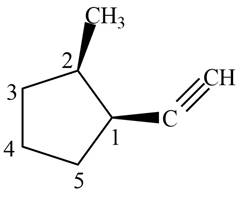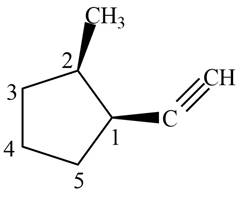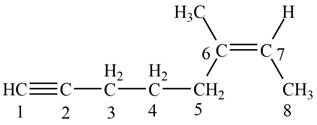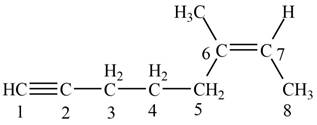
(a)
Interpretation: The structure corresponding to the given name,
Concept introduction: The systematic naming of organic compound is given by IUPAC. The full form of IUPAC is International Union of Pure and Applied Chemistry. The naming of organic compound is done such that the structure of organic compound is correctly interpreted from the name.
Answer to Problem 11.29P
The structure corresponding to the given name,

Explanation of Solution
The structure corresponding to the given name,

Figure 1
This compound contains seven carbon atoms in the longest carbon chain and a triple bond at
The structure corresponding to the given name is shown in Figure 1.
(b)
Interpretation: The structure corresponding to the given name,
Concept introduction: The systematic naming of organic compound is given by IUPAC. The full form of IUPAC is International Union of Pure and Applied Chemistry. The naming of organic compound is done such that the structure of organic compound is correctly interpreted from the name.
Answer to Problem 11.29P
The structure corresponding to the given name,

Explanation of Solution
The structure corresponding to the given name,

Figure 2
This compound contains nine carbon atoms in the longest carbon chain and a triple bond at
The structure corresponding to the given name is shown in Figure 2.
(c)
Interpretation: The structure corresponding to the given name,
Concept introduction: The systematic naming of organic compound is given by IUPAC. The full form of IUPAC is International Union of Pure and Applied Chemistry. The naming of organic compound is done such that the structure of organic compound is correctly interpreted from the name.
Answer to Problem 11.29P
The structure corresponding to the given name,

Explanation of Solution
The structure corresponding to the given name,

Figure 3
This compound contains five carbon atoms in the longest carbon chain and a triple bond at
The structure corresponding to the given name is shown in Figure 3.
(d)
Interpretation: The structure corresponding to the given name,
Concept introduction: The systematic naming of organic compound is given by IUPAC. The full form of IUPAC is International Union of Pure and Applied Chemistry. The naming of organic compound is done such that the structure of organic compound is correctly interpreted from the name.
Answer to Problem 11.29P
The structure corresponding to the given name,

Explanation of Solution
The structure corresponding to the given name,

Figure 4
This compound contains five carbon atoms arranged in a cyclic carbon chain and a triple bond is present outside the cyclic chain. Thus, the five membered cyclic chain of carbon is known to be cyclopentane. One ethynyl group is present at
The structure corresponding to the given name is shown in Figure 4.
(e)
Interpretation: The structure corresponding to the given name,
Concept introduction: The systematic naming of organic compound is given by IUPAC. The full form of IUPAC is International Union of Pure and Applied Chemistry. The naming of organic compound is done such that the structure of organic compound is correctly interpreted from the name.
Answer to Problem 11.29P
The structure corresponding to the given name,

Explanation of Solution
The structure corresponding to the given name,

Figure 5
This compound contains eight carbon atoms arranged in a longest carbon chain and two triple bonds are present at
The structure corresponding to the given name is shown in Figure 5.
(f)
Interpretation: The structure corresponding to the given name,
Concept introduction: The systematic naming of organic compound is given by IUPAC. The full form of IUPAC is International Union of Pure and Applied Chemistry. The naming of organic compound is done such that the structure of organic compound is correctly interpreted from the name.
Answer to Problem 11.29P
The structure corresponding to the given name,

Explanation of Solution
The structure corresponding to the given name,

Figure 6
This compound contains eight carbon atoms arranged in a longest carbon chain, one double bond at
The structure corresponding to the given name is shown in Figure 6.
Want to see more full solutions like this?
Chapter 11 Solutions
Organic Chemistry
- Indicate the products obtained by mixing 2,2-dimethylpropanal with acetaldehyde and sodium ethoxide in ethanol.arrow_forwardSynthesize 2-Ethyl-3-methyloxirane from dimethyl(propyl)sulfonium iodide using the necessary organic or inorganic reagents. Draw the structures of the compounds.arrow_forwardSynthesize 2-Hydroxy-2-phenylacetonitrile from phenylmethanol using the necessary organic or inorganic reagents. Draw the structures of the compounds.arrow_forward
- Synthesize N-Methylcyclohexylamine from cyclohexanol using the necessary organic or inorganic reagents. Draw the structures of the compounds.arrow_forwardSynthesize N-Methylcyclohexylamine from cyclohexanol using the necessary organic or inorganic reagents. Draw the structures of the compounds.arrow_forwardIf possible, please provide the formula of the compound 3,3-dimethylbut-2-enal.arrow_forward
- Synthesize 1,4-dibromobenzene from acetanilide (N-phenylacetamide) using the necessary organic or inorganic reagents. Draw the structures of the compounds.arrow_forwardIndicate the products obtained by mixing (3-oxo-3-phenylpropyl)triphenylphosphonium bromide with sodium hydride.arrow_forwardWe mix N-ethyl-2-hexanamine with excess methyl iodide and followed by heating with aqueous Ag2O. Indicate the major products obtained.arrow_forward
- Indicate the products obtained by mixing acetophenone with iodine and NaOH.arrow_forwardIndicate the products obtained by mixing 2-Propanone and ethyllithium and performing a subsequent acid hydrolysis.arrow_forwardIndicate the products obtained if (E)-2-butenal and 3-oxo-butanenitrile are mixed with sodium ethoxide in ethanol.arrow_forward
 Organic Chemistry: A Guided InquiryChemistryISBN:9780618974122Author:Andrei StraumanisPublisher:Cengage Learning
Organic Chemistry: A Guided InquiryChemistryISBN:9780618974122Author:Andrei StraumanisPublisher:Cengage Learning
